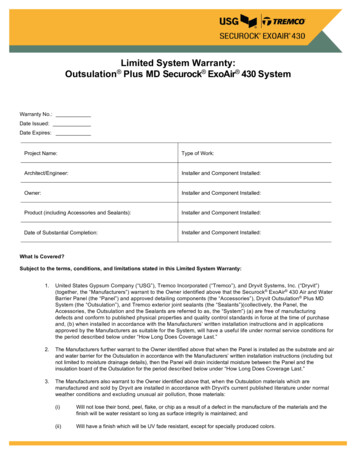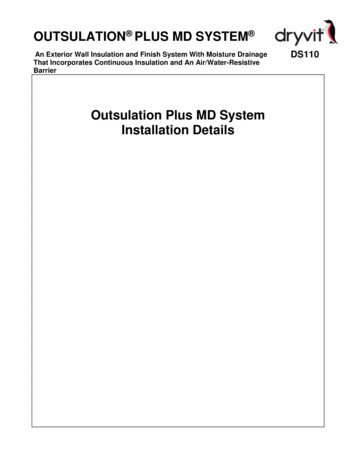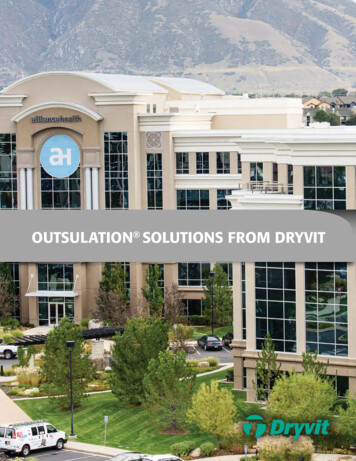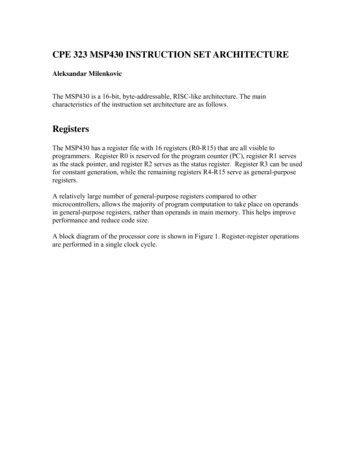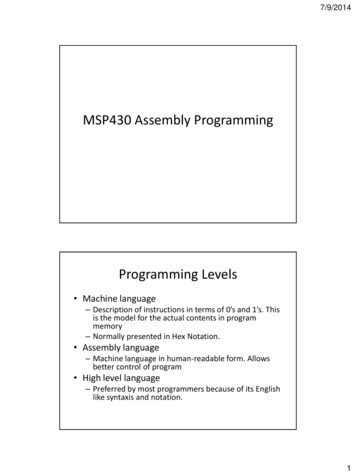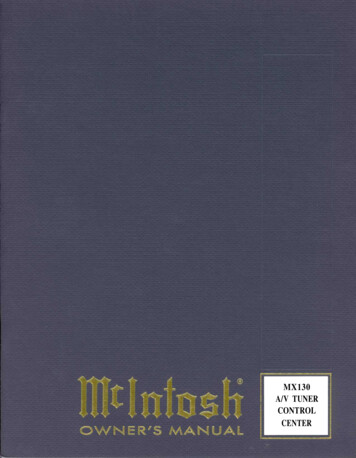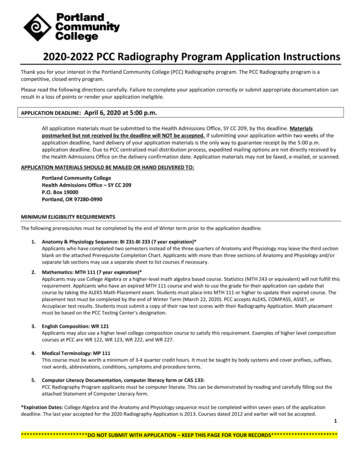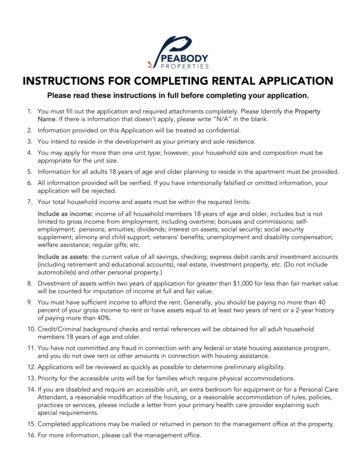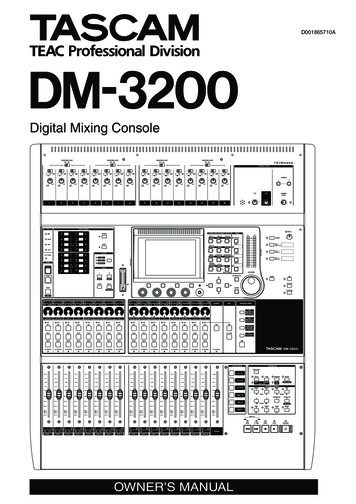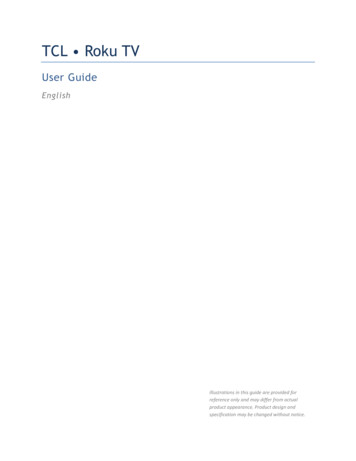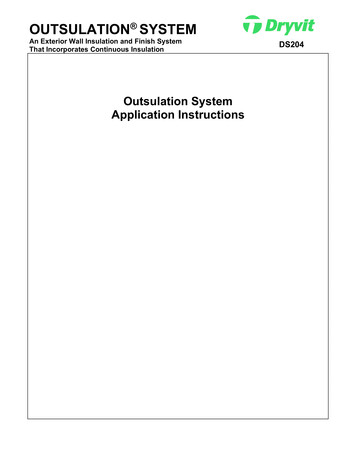
Transcription
OUTSULATION SYSTEMAn Exterior Wall Insulation and Finish SystemThat Incorporates Continuous InsulationOutsulation SystemApplication InstructionsDS204
Outsulation System Application InstructionsDS204Table of ContentsSection IGeneral Installation RequirementsSection IIMaterials Required for Completing Installation of the Outsulation SystemSection IIIMixing InstructionsSection IVRough Opening Preparation OptionsSection VSubstrate Expansion Joint Bridging OptionsSection VIInsulation Board InstallationSection VIIInstallation of Reinforcing Mesh and Base CoatSection VIIISealant Joint PreparationSection IXDryvit PrimersSection XDryvit FinishSection XICoatings and SealersSection XIIMaintenance and Repair2
Outsulation System Application InstructionsDS204I. General Installation RequirementsA. Project Conditions1. Storagea. Materials shall be stored at the job site, and at all times, in a cool, dry location, out of direct sunlight, protectedfrom weather and other sources of damage. Minimum storage temperature shall be as follows:1) DPR, PMR , HDP , Weatherlastic , and E Finishes , Color Prime , Primus , Genesis andNCB : 40 F (4 C).2) For all other products, refer to specific product data sheets.b. Maximum storage temperature shall not exceed 100 F (38 C). NOTE: Minimize exposure of materials totemperatures over 90 F (32 C). Finishes exposed to temperatures over 110 F (43 C) for even shortperiods may exhibit skinning, increased viscosity and should be inspected prior to use.c. Protect all products from inclement weather and direct sunlight.2. Applicationa. Application of wet materials shall not take place during inclement weather unless appropriate protection isprovided. Protect materials from inclement weather until they are completely dry.1) At the time of Dryvit product application, the air and wall surface temperatures shall be from 40 F (4 C)minimum to 100 F (38 C) maximum for the following products:a) DPR, PMR, HDP, Weatherlastic and E Finishes, Color Prime, Primus, Genesis and NCB: 40 F (4 C).b) For all other products, refer to specific product data sheets.B. Inspection of Substrate1. Acceptable substrates for application of the Dryvit Outsulation System are listed in the Dryvit Outsulation SystemSpecification, DS118.2. The substrate must be securely fastened per contract documents.3. The substrate attachment method must comply with all contract documents.4. The substrate must be clean, dry, structurally sound, free of loose material, voids, projections, hot spots, releaseagents, coatings, or other materials that may affect adhesion.5. There shall be no planar irregularities greater than 1/4 in (6.4 mm) within any 4 ft (1.2 m) radius.6. Wood based sheathings require a 1/8 in (3.2 mm) gap between adjacent sheets per the guidelines published by theAPA.C. Flashing at System Terminations1. Generala. Ensure that flashing is installed in accordance with applicable code requirements and the contract documents.As a minimum, opening preparation is required as shown in the Outsulation System Installation Details, DS107.2. Transition at Roof Linesa. Ensure the roof has positive drainage, i.e. all runoff shall be directed to the exterior and away from the structure.b. Roof flashing (by others) shall be installed in accordance with industry guidelines, manufacturer’s instructionsand contract documents.c. Runoff diverters (i.e. kickouts, crickets and saddles) (by others) shall be installed in accordance with industryguidelines, manufacturer's instructions and contract documents. Particular attention must be paid to theeaves/chimney intersections and sloped roof/wall intersections. Refer to the Dryvit Outsulation SystemInstallation Details, DS107.d. Hold system a minimum of 8 in (203 mm) above flat roofs; 2 in (51 mm) above sloped roofs.3. Openingsa. Heads, jambs and sills of all openings shall be prepared with AquaFlash System, Backstop Flash & Fill orother approved flashing material selected by the design professional prior to window/door, mechanicalequipment, or other component installation. For proper application, refer to the Dryvit Outsulation SystemInstallation Details, DS107. NOTE: Sill piece shall extend to the inside face of wall and continue aminimum of 12 in (305 mm) up at the jambs.b. Continuous flashing at heads of openings as indicated in contract documents. NOTE: For windows or doorsthat do not have integral flashing, a field-applied flashing shall be installed (by others) in accordancewith industry guidelines, manufacturer's instructions and contract documents. Refer to the DryvitOutsulation System Installation Details, DS107.c. Individual windows that are ganged to make multiple units require the heads to be continuously flashed and thejoints between the units to be fully sealed.4. Decks and Patiosa. Wood decks shall be properly flashed prior to system application. See the Dryvit Outsulation System InstallationDetails, DS107.b. Verify that the system terminates above poured decks, patios, landings, etc. and that they are properly slopedand waterproofed to direct water away from the walls.3
Outsulation System Application InstructionsDS2045. Utilitiesa. Provisions must be made to ensure that the system terminates properly at lighting fixtures, electrical outlets,hose bibs, dryer vents, etc. Refer to the Dryvit Outsulation System Installation Details, DS107, for generalinformation and guidance.6. Grade Level Terminationsa. Hold system a minimum of 8 in (203 mm) above finished grade.D. Sealants1. Dryvit materials shall be completely dry prior to installation of sealant materials (typically 48 - 72 hours). Humid orcool conditions may require longer drying times.Notify the general contractor and/or architect and/or owner of all discrepancies. Do not proceed until allunsatisfactory conditions have been corrected.II. Materials Required for Completing Installation of the Outsulation SystemA. Materials Supplied by Dryvit Systems, Inc.1. AquaFlash and AquaFlash Mesh2. Backstop Flash & Fill3. AP Adhesive4. ADEPS 5. Genesis , Genesis DM, and Genesis DMS6. Primus , Primus DM7. Dryflex 8. NCB 9. Rapidry DM 35-50, Rapidry DM 50-75, RapidPatch 10. Standard Mesh, Standard Plus Mesh, Intermediate Mesh, Panzer 15, Panzer 20, Corner Mesh, and Detail Mesh a. It shall be colored blue for product identification bearing the Dryvit logo.11. Dryvit Finishes12. Dryvit Coatings and Primers13. Pre-Coated Starter Boards - optionalNOTE: Materials listed above are those contained or referenced in the Outsulation Specification, DS118.Typically, the project specification will identify the specific materials necessary to complete application.B. Materials Supplied by Others1. Portland cement: Type I or II2. Clean Potable Water3. Expanded Polystyrene Insulation Board meeting DS131III. Mixing InstructionsA. General1. No additives such as sand, aggregates, rapid binders, anti-freeze, accelerators, etc. shall be added to any Dryvitmaterials under any circumstances. Such additives will adversely affect the performance of the material andvoid all warranties.B. Opening Preparation Materials1. AquaFlasha. Open the bucket with a utility knife or lid-off.b. AquaFlash is ready to use after an initial spin-up using a “Twister” paddle or equivalent mixing blade, powered bya 1/2 in (12.7 mm) drill, at 450 - 500 rpm. Do not add cement or any other additives.C. Adhesive only1. ADEPSa. Mix the ADEPS adhesive to a smooth homogeneous consistency using a “Twister” paddle or equivalent mixingblade, powered by a 1/2 in (12.7 mm) drill, at 450 - 500 rpm. Do not add water or any other additives.D. Adhesive and Base Coat1. Primus, or Genesisa. Open the bucket with a utility knife or lid-off.b. Due to shipping and storage, there may be some separation of materials. Prior to splitting the material andadding Portland cement, mix the material thoroughly. Use a “Twister” paddle or equivalent mixing bladepowered by a 1/2 in (12.7 mm) drill, at 500 - 1200 rpm only. NOTE: A minimum 7 amp drill works best forPortland cement based materials. CAUTION: Do not over-mix or use other types of mixing blades as airentrapment and product damage may occur and result in workability and performance problems.c. Pour 1/2 of the freshly mixed material [approximately 30 lbs (13.5 kg)] into a clean plastic container.4
Outsulation System Application InstructionsDS204d. Add 1/3 of a bag [approximately 30 lbs (13.5 kg)] of fresh, lump free Type I or II Portland cement. Either gray orwhite cement is acceptable. Add cement slowly and mix thoroughly. Do not add large quantities of cement atone time.e. Clean potable water may be added to the mixture to adjust the workability.1) Primusa) Add as little water as possible, in small increments, and only after the Portland cement is thoroughlymixed. Do not over water as this will degrade the performance and promote efflorescence.b) Mix the Primus material with Portland cement thoroughly; then wait five - ten (5 - 10) minutes, then breakthe initial set. Retempering, with a small amount of water is permissible provided the mixture has not set.The mixture has a pot life similar to other Portland cement plaster material. Mix only as much material ascan be conveniently used during a work period.2) Genesisa) Add 1 qt (950 ml) of water prior to adding Portland cement. Additional water may be added to adjustworkability.b) Mix the Genesis material with Portland cement thoroughly; then wait five - ten (5 – 10) minutes, thenbreak the initial set. Retempering with a small amount of water is permissible provided the mixture has notset. The mixture has a pot life similar to other Portland cement plaster material. Mix only as muchmaterial as can be conveniently used during a work period2. Primus DMa. Pail Mixing1) One 50 lb (22.7 kg) bag of material will produce approximately 5 gal (19 L) of Primus DM mixture. Add1.5 gal (5.7 L) of clean potable water into a clean plastic container.2) Add Primus DM slowly while mixing using a “Twister” paddle or equivalent mixing blade, powered by a1/2 in (12.7 mm) drill, at 500 - 1200 rpm. NOTE: A minimum 7 amp drill works best for Portland cementbased materials.3) Thoroughly mix until uniformly wetted, adjusting consistency with a small amount of water or Primus DMmaterial.4) Allow the mixture to set a minimum of five - ten (5 - 10) minutes and mix again to break the initial set.Retemper adding a small amount of water if necessary. Material must be free of lumps before using.b. Mortar Mixer1) Add 1.5 gal (5.7 L) of clean potable water for each 50 lb (22.7 kg) bag of Primus DM into a clean mortarmixer.2) Add the Primus DM while the mixer is running. Mix three to five (3 – 5) minutes, shut mixer off five - ten (5 10) minutes then run mixer for another two to three (2 – 3) minutes to break the initial set adding a smallamount of water if necessary to adjust the workability. The pot life is one to three (1 - 3) hours depending onweather.3. Genesis DMa. Pail Mixing1) One bag of Genesis DM will produce approximately 5 gal (19 L) of Genesis DM mixture. To a clean5 gal (19 L) pail, add 6 - 7 qt (5.7 - 6.6 L) of clean potable water.2) Add the Genesis DM slowly while constantly mixing with a “Twister” paddle or equivalent mixing blade,powered by a 1/2 in (12.7 mm) drill, at 500 - 1200 rpm. NOTE: A minimum 7 amp drill works best forPortland cement based materials.3) Thoroughly mix until uniformly wetted, adjusting consistency with a small amount of water or Genesis DMmaterial.4) Allow the mixture to set a minimum of five - ten (5 - 10) minutes and mix again to break the initial set.Retemper, adding a small amount of water if necessary. Material must be free of lumps before using.b. Mortar Mixer1) Add 6 - 7 qt (5.7 - 6.6 L) of clean potable water for each 50 lb (22.7 kg) bag of Genesis DM into a cleanmortar mixer.2) Add the Genesis DM while the mixer is running. Mix three to five (3 – 5) minutes, shut the mixer off for five ten (5 - 10) minutes, then run mixer for another two to three (2 – 3) minutes to break the initial set adding asmall amount of water if necessary to adjust workability. The pot life is one to one and one half (1 – 1 1/2)hours depending on weather.4. Genesis DMSa. Sprayer1) Connect a source of clean, cool potable water to a spray machine suitable for EIFS applications.2) Regulate the water flow rate to provide the desirable mixing consistency of material. Material may thicken upupon leaving the mixing cylinder at a given water flow and loosen up after pumping.NOTE: The consistency for application must be determined after pumping.5
Outsulation System Application InstructionsDS204b. Pail Mixing1) One bag of Genesis DMS will produce approximately 5 gal (19 L) of Genesis DMS mixture. To a clean5 gal (19 L) pail, add 7 - 9 qt (6.6 - 8.5 L) of clean, cool potable water.2) Add the Genesis DMS slowly while continuously mixing with a “Twister” paddle or equivalent mixing blade,powered by a 1/2 in (12.7 mm) drill, at 500 - 1200 rpm. NOTE: A minimum 7 amp drill works best forPortland cement based materials.3) Thoroughly mix until uniformly wetted, adjusting consistency with a small amount of water or Genesis DMSmaterial.4) Allow the mixture to set for five - ten (5 - 10) minutes and mix again to break the initial set. Retemper, addinga small amount of water if necessary. Material must be free of lumps before using.c. Mortar Mixer1) Add 7 - 9 qt (6.6 - 8.5 L) of clean, cool potable water for each 50 lb (22.7 kg) bag of Genesis DMS into aclean mortar mixer.2) Add the Genesis DMS while the mixer is running. Mix three to five (3 – 5) minutes, shut the mixer off forfive - ten (5 - 10) minutes, then run mixer for another two to three (2 – 3) minutes to break the initial set.Retemper, adding a small amount of water if necessary. Material must be free of lumps before using. Thepot life is one to three (1 - 3) hours depending on weather.5. Rapidry DM 35-50a. Pail Mixing1) One 50 lb (22.7 kg) bag of Rapidry DM 35-50 will produce approximately 19 L (5 gal) of Rapidry DM35-50 mixture. To a clean Dryvit 5 gal (19 L) pail, add 6.5 qt (6.1 L) of clean potable water. As analternative, on the inside of the Dryvit 5 gal (19 L) pail, draw a horizontal line which measures 4 7/16 in(13 mm) from the base of the pail and fill with water.2) Add the Rapidry DM 35-50 slowly while mixing with a “Twister” paddle or equivalent mixing blade, poweredby a 1/2 in (12.7 mm) drill, at 500 - 1200 rpm. NOTE: A minimum 7 amp drill works best for Portlandcement based materials.3) Thoroughly mix until uniformly wetted, adjusting consistency with a small amount of water or Rapidry DM35-50 material. Material must be free of lumps before using.4) Let set for five - ten (5 - 10) minutes and mix again to break the initial set. Retemper, adding a small amountof water if necessary. Material must be free of lumps before using.b. Mortar Mixer1) Add 6.5 qt (6.1 L) of clean potable water for each 50 lb (22.7 kg) bag of Rapidry DM 35-50 into a clean mortarmixer.22) Add the Rapidry DM 35-50 while the mixer is running. Mix for three to five (3 – 5) minutes, shut the mixeroff for five - ten (5 - 10) minutes, then run mixer for another two to three (2 – 3) minutes to break the initialset adjusting consistency with a small amount of water or Rapidry DM 35-50 if necessary. Material must befree of lumps before using. The pot life is approximately 30 minutes depending on temperature.6. Rapidry DM 50-75a. Pail Mixing1) One 20.4 (45 lb) bag of Rapidry DM 50-75 will produce approximately 5 gal (19 L) of Rapidry DM50-75 mixture. To a clean Dryvit 5 gal (19 L) pail, add 5.5 qt (5.2 L) of clean potable water. As analternative, on the inside of the Dryvit 5 gal (19 L) pail, draw a horizontal line which measures 3 13/16 in(97 mm) from the base of the pail and fill with water.2) Add the Rapidry DM 50-75 slowly while mixing with a “Twister” paddle or equivalent mixing blade, poweredby a 1/2 in (12.7 mm) drill, at 500 - 1200 rpm. NOTE: A minimum 7 amp drill works best for Portlandcement based materials.3) Thoroughly mix until uniformly wetted, adjusting consistency with a small amount of water or Rapidry DM50-75 material.4) Let set for five - ten (5 - 10) minutes and mix again to break the initial set. Retemper, adding a small amountof water if necessary. Material must be free of lumps before using.b. Mortar Mixer1) Add 5.5 qt (5.2 L) of clean potable water for each 45 lb (20.4 kg) bag of Rapidry DM 50-75 into a clean mortarmixer.2) Add the Rapidry DM 50-75 while the mixer is running. Mix for three to five (3 – 5) minutes, shut the mixer offfor five - ten (5 - 10) minutes, then run mixer for another two to three (2 – 3) minutes to break the initial setadjusting consistency with a small amount of water or Rapidry DM 50-75 if necessary. Material must be freeof lumps before using. The pot life is approximately 30 minutes depending on temperatureE. Base Coat only1. NCBa. Open the bucket with a utility knife or lid-off.b. Mix NCB to a smooth, homogeneous consistency with a “Twister” paddle or equivalent mixing blade, powered bya 1/2 in (12.7 mm) drill, at 450 - 500 rpm. A small amount of clean potable water may be added to adjustworkability.6
Outsulation System Application InstructionsDS2042. Dryflexa. Open the bucket with a utility knife or lid-off.b. Due to shipping and storage, there may be some separation of materials. Prior to splitting the material andadding Portland cement, mix the material thoroughly. Use a “Twister” paddle or equivalent mixing blade,powered by a 1/2 in (12.7 mm) drill, at 500 - 1200 rpm. NOTE: A minimum 7 amp drill works best forPortland cement based materials. CAUTION: Do not over-mix or use other types of mixing blades asair entrapment and product damage may occur and result in workability and performance problems.c. Pour 1/2 of the freshly mixed material [approximately 22.5 lbs (10.21 kg)] into a clean plastic container.d. Add 1/4 of a bag [approximately 22.5 lbs (10.21 kg)] of fresh, lump free Type I or II Portland cement. Either grayor white cement is acceptable. Add cement slowly and mix thoroughly. Do not add large quantities ofcement at one time.e. Clean potable water may be added to the mixture to adjust the workability. Add as little water as possible, insmall increments, and only after the Portland cement is thoroughly mixed. Do not over-water as this willdegrade the performance and promote efflorescence. NOTE: It is advisable to mix the Dryflex materialwith Portland cement thoroughly; allow the mixture to set for five – ten (5 - 10) minutes and mix again tobreak the initial set. Retempering with a small amount of water is permissible provided the mixture hasnot set. The mixture has a pot life similar to any Portland cement material. Mix only as much materialas can be conveniently used during a work period.F. Primers1. Color Prime , Color Prime W , Primer with Sand , Weatherprime , and Prymit a. Mix material with a “Twister” paddle or equivalent mixing blade, powered by a 1/2 in (12.7 mm) drill, at450 - 500 rpm to a homogeneous consistency.G. Finishes1. Quarzputz , Quarzputz E, Sandblast , Freestyle , Sandpebble , Sandpebble E, Sandpebble Fine, Sandpebble Fine E, HDP Finishes, and Weatherlastic finishesa. Thoroughly mix the factory-prepared Dryvit finish with a “Twister” paddle or equivalent mixing blade powered bya 1/2 in (12.7 mm) drill, at 450 - 500 rpm, until a uniform, homogeneous consistency is attained. A small amountof clean potable water may be added to adjust workability. Always add the same amount of water to each pailwithin a given lot to avoid color variation.H. Specialty Finishes1. Ameristonea. Mix Ameristone for approximately one (1) minute to ensure uniformity using a “Twister” paddle or equivalentmixing blade powered by a 1/2 in (12.7 mm) drill, at 450 - 500 rpm, just prior to application. DO NOT OVERMIX.b. Mix all pails for the same amount of time.c. If clean potable water is added as described in Ameristone Spray Application Instructions, DS142 for variousapplication techniques, the same amount must be added to each pail.2. Stone Mist a. Mix Stone Mist for one (1) minute to ensure uniformity using a “Twister” paddle or equivalent mixing blade,powered by a 1/2 in (12.7 mm) drill, 450 - 500 rpm, just prior to application. DO NOT OVERMIX.3. TerraNeoa. Mix TerraNeo for one (1) minute just prior to application, to ensure uniformity using a “Twister” paddle orequivalent mixing blade, powered by a 1/2 in (12.7 mm) drill, at 450 - 500 rpm. DO NOT OVERMIX.4. Lymestonea. Mix Lymestone with a “Twister” paddle or equivalent mixing blade, powered by a 1/2 in (12.7 mm) drill, at450 - 500 rpm until a uniform workable consistency is attained.5. Custom Brick Finishesa. For Custom Brick finishes, refer to Dryvit Custom Brick Application Instructions, DS154, for completemixing instructions.6. Finesse a. Mix Finesse with a “Twister” paddle or equivalent mixing blade, powered by a 1/2 in (12.7 mm) drill, at450 - 500 rpm until a uniform workable consistency is attained.7. Tibur Stonea. Mix Tibur Stone with a “Twister” paddle or equivalent mixing blade, powered by a 1/2 in (12.7 mm) drill, at450 - 500 rpm until a uniform workable consistency is attained.8. Reflectit a. Refer to Reflectit Data Sheet DS705 and Application Instructions DS124 for complete instructions.I. Coatings and Sealers1. Demandit Smooth, Demandit Sanded, Weathercoat , and Weatherlastic Smootha. Mix material with a “Twister” paddle or equivalent mixing blade, powered by a 1/2 in (12.7 mm) drill, at450 - 500 rpm to a homogeneous consistency.7
Outsulation System Application InstructionsDS2042. Tuscan Glaze a. Mix Tuscan Glaze with a “Twister” paddle or equivalent mixing blade, powered by a 1/2 in (12.7 mm) drill, at450 - 500 rpm to a homogeneous consistency, immediately prior to application. As an alternate, boxing ofbuckets is acceptable. Continuously agitate throughout application to ensure color consistency.3. SealClear a. Stir material thoroughly before using and stir often during the application process. As an alternate, boxing ofbuckets is acceptable.IV. Rough Opening Preparation OptionsA. AquaFlash System Option1. AquaFlash must be installed to provide a continuous barrier from the sheathing substrate onto the framing edges atdiscontinuities and terminations such as openings, expansion joints, tops of parapets, etc. Refer to DryvitOutsulation System Installation Details, DS107.2. Surface Preparationa. Apply only when air and surface temperatures are above 40 F (4 C).b. The surface to receive the AquaFlash System must be clean, dry, smooth and free of any condition that willhinder adhesion.c. Clean loose dust or dirt from the surface by wiping with a clean, dry cloth or brush.3. AquaFlash System Applicationa. Rough Openings (Windows, Doors, Others)1) Cut AquaFlash Mesh to proper length [rough opening plus 4 in (102 mm)] extending 2 in (51 mm) past eachjamb – Figure 1.Figure 12) Begin at the sill of an opening. Using a brush or 3/4 in (19 mm) nap roller, apply a liberal coat of AquaFlashliquid material to the substrate surface. NOTE: The AquaFlash System must extend to the interior faceof the wall opening.3) Immediately lay the AquaFlash Mesh into the wet material and brush smooth adding additional material tocompletely embed the mesh - Figure 2.Figure 24) Install the AquaFlash System at the jambs in the same manner overlapping onto the sill material a minimum of2 in (51 mm) - Figure 3.2 in Min.(51 mm)Figure 38
Outsulation System Application InstructionsDS2045) Install the AquaFlash System at the head overlapping the jamb pieces a minimum of 51 mm (2 in) -Figure 4.2 in Min.(51 mm)Figure 45a) As an alternative, preformed Dryvit AquaFlash Corners can be applied at each corner of the opening toreduce the number of field cuts required. The AquaFlash Corners are installed in the same manner as theAquaFlash Mesh. – Figure 5.Figure 56) Install diagonal “butterflies” consisting of AquaFlash Liquid and AquaFlash Mesh at each sill/jamb corner Figure 6.Figure 67) Allow material to set for approximately 15 minutes then apply a second liberal coat of AquaFlash Liquid andsmooth out to ensure a continuous film free of voids, pinholes, or other discontinuities.4. Sill Pan Flashing (Exposed)a. Install a watertight pan flashing at all sill locations - Figure 7.b. The flashing shall extend between the framing members of the rough opening and shall be sized to protect thesill, sheathing and the surface of the Outsulation System. It must include vertical legs at the back and sides toensure proper collection of water. NOTE: All flashing shall be continuous, have watertight seams, andshall be configured to shed all water to the exterior of the system. Apply a strip of Aquaflash Mesh overthe vertical legs of the pan flashing to seal the pan to the jambs.9
Outsulation System Application InstructionsDS204c. The flashing shall extend a minimum of 2 1/2 in (64 mm) down over the face of the Outsulation SystemFigure 7.2 1/2 in Min.(64 mm)Figure 75. Sill Pan Flashing (Concealed) for use with nail-on-windows (refer to Dryvit Outsulation Installation Details, DS107).a. Install a watertight pan flashing at all sill locations.b. The flashing shall extend between the framing members of the rough opening and shall be sized to protect thesill and sheathing. It must include vertical legs at the back and sides to ensure proper collection of water. Itshall extend a minimum of 4 in (102 mm) below the opening and have a sloped horizontal leg which continuesover the top edge of the Outsulation System. NOTE: All flashing shall be continuous, have watertightseams, and shall be configured to shed all water to the exterior of the system. Apply a strip ofAquaflash Mesh over the vertical legs of the pan flashing to seal the pan to the jambs.6. Installation of AquaFlash Over Metal or PVC Flashing Materialsa. The AquaFlash System may be applied directly over clean galvanized, painted metal, or PVC flashing.b. Prepare rough opening as described in Section IV.A.3.c. Install flashing material per contract documents.d. Clean the surface of the flashing to ensure that it is free of dirt, dust, oil, or other contaminants that may interferewith adhesion. NOTE: PVC products should be lightly abraded to break the surface skin and providetooth for the coating.e. Cut AquaFlash Mesh to proper length [flashing plus 4 in (102 mm) extending 2 in (51 mm) beyond each end offlashing] - Figure 8.Figure 8f. Using a brush or 3/4 in (19 mm) nap roller, apply a liberal coat of AquaFlash Liquid material to the flashing andadjacent substrate surface.g. Immediately lay the AquaFlash Mesh into the wet material and brush smooth adding additional material tocompletely embed the mesh.h. Allow material to set for 15 minutes then apply a second liberal coat of AquaFlash liquid and smooth out toensure a continuous film free of voids, pinholes, or other discontinuities and allow to dry.B. Backstop Flash & Fill Option1. Backstop Flash & Fill may be used to treat openings and sheathing joints.2. Refer to product Data Sheet DS848 for complete information.V. Substrate Expansion Joint Bridging OptionsA. AquaFlash System Option1. Surface Preparationa. Apply only when air and surface temperatures are above 40 F (4 C).b. The surface to receive AquaFlash System must be clean, dry, smooth and free of any condition that will hinderadhesion.c. Clean loose dust or dirt from the surface by wiping with a clean, dry cloth or brush.2. AquaFlash System Applicationa. The width of the AquaFlash Mesh must overlap each side of the joint a minimum of 2 in (51 mm) – Figure 9.b. Clean the joint to allow for the installation of a backer material. Install a closed cell polyethylene backer rodsized a minimum of 50% larger than the joint width. Install so that the backer rod is recessed or projects aminimum of 1/4 in (6.4 mm) from the wall surface.10
Outsulation System Application InstructionsDS2042 in(51 mm) Min.1/4 in6.4 mm Min.Projection1/4 in(6.4 mm) Min.RecessFigure 9c. Using a brush or 3/4 in (19 mm) nap roller, apply a liberal coat of AquaFlash Liquid material to the backer rodand adjacent substrate surface to the width of the AquaFlash Mesh - Figure 10.Figure 10d. Immediately lay the AquaFlash Mesh into the wet material and brush smooth adding additional material tocompletely embed the mesh.e. Allow material to set for 15 minutes then apply a second liberal coat of AquaFlash Liquid and smooth out toensure a continuous film free of voids, pinholes, or other discontinuities.VI. Insulation Board InstallationA. System Terminations1. Attach Detail Mesh around the perimeter of all openings, penetrations, and other system terminations by stapling orapplying a ribbon of adhesive mixture on the substrate and embedding the Detail Mesh into the wet mixture.2. Position the Detail Mesh so that a minimum of 2 1/2 in (64 mm) will extend onto the face of the insulation board.Keep the mesh, which is not embedded, clean.3. Pre-coated Starter Boardsa. Pre-coated Starter Boards shall be used at the base of walls as shown in Detail No. OS.0.0.01a .b. Using a stainless steel trowel, apply the adhesive vertically with a notched trowel.c. Press the Starter Board at the base of the wall firmly.B. Inspection of the Insulation Board1. Prior to installing the insulation board, it shall be checked to ensure that:a. It is shipped in a clear polyethylene bag bearing the Dryvit name. In addition, the lot number of the insulationboard shall be visible on the outside of the bag. Insulation board shall be obtained from Dryvit Systems, Inc. orits authorized distributors, and made exclusively by manufacturers listed by Dryvit Systems, Inc.b. One edge of each board shall bear the word Dryvit, the plant identification number of the block molder, theappropriate model code report number, and the name of the third party quality control agency withcorresponding number. In addition, one
Outsulation System Application Instructions DS204 . 3 . I. General Installation Requirements . A. Project Conditions . 1. Storage . a. Materials shall be stored at the job site, and at all times, in a cool, dry location, out of direct sunlight, protected
